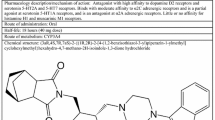Abstract
A group of 26 acute psychotic patients received continuous oral treatment with perphenazine for a period of 5 weeks. Once-weekly blood samples were drawn for measurements of perphenazine levels and, simultaneously, the therapeutic outcome was registered. Another 26 acute psychotic patients received continuous oral treatment with perphenazine for a period of up to 4 weeks. A single blood sample was drawn and the perphenazine concentration was related to the appearance of extrapyramidal side effects. The following conclusions were made: (1) a high risk of provoking extrapyramidal side effects was associated with plasma levels of perphenazine above 3 nmol/l; (2) plasma levels below 2 nmol/l were associated with a poor therapeutic outcome; (3) a ‘therapeutic window’ between 2 and 3 nmol/l gives maximal therapeutic effect with a low risk of provoking extrapyramidal side effects.
Similar content being viewed by others
References
Bolvig Hansen L, Laren NE (1977) Plasma concentrations of perphenazine and its sulphoxide metabolite during continuous oral treatment. Psychopharmacology 53:127–130
Bolvig Hansen L, Larsen NE, Vestergård P (1981) Plasma levels of perphenazine (Trilafon) related to development of extrapyramidal side effects. Psychopharmacology 74:306–309
Buyze G, Egberts PFC, Muunsze RG, Poslavska A (1973) Blood levels of thioridazine and some of its metabolites in psychiatric patients: A preliminary report. Psychiatr Neurol Neurochir 76:229–239
Cooper TB (1978) Plasma level monitoring of antipsychotic drugs. Clin Pharmacokinet 3:14–38
Davis JM, Janowska DS, Sekerti HJ, Manier D, El-Yousef MK (1974) The pharmacokinetics of butaperazine in serum. In: Forrest IS, Carr CJ, Usdin E (eds) Phenothiazines and structurally related drugs. Raven, New York, pp 433–443
Feighner JP, Robbins E, Guze SB (1972) Diagnostic criteria for use in psychiatric research. Arch Psychiatry 26:57–63
Larsen NE, Naestoft J (1975) Determination of perphenazine and its sulphoxide in human plasma after therapeutic doses by gas chromatography. J Chromatogr 109:259–264
Mjørndal T, Oreland L (1971) Determination of thioxanthenes in plasma at therapeutic concentrations. Acta Pharmacol Toxicol (Copenh) 29:295–302
Overall JE, Gorham DR (1962) The brief psychiatric rating scale. Psychol Rep 10:799–812
Simpson GM, Angus JWS (1970) A rating scale for extrapyramidal side effects. Acta Psychiatr Scand (Suppl) 212:11–25
Wiles DH, Franklin M (1978) Radioimmunoassay for fluphenazine in human plasma. Br J Clin Pharmacol 5:265–268
Author information
Authors and Affiliations
Rights and permissions
About this article
Cite this article
Hansen, L.B., Larsen, NE. & Gulmann, N. Dose-response relationships of perphenazine in the treatment of acute psychoses. Psychopharmacology 78, 112–115 (1982). https://doi.org/10.1007/BF00432245
Received:
Accepted:
Issue Date:
DOI: https://doi.org/10.1007/BF00432245




